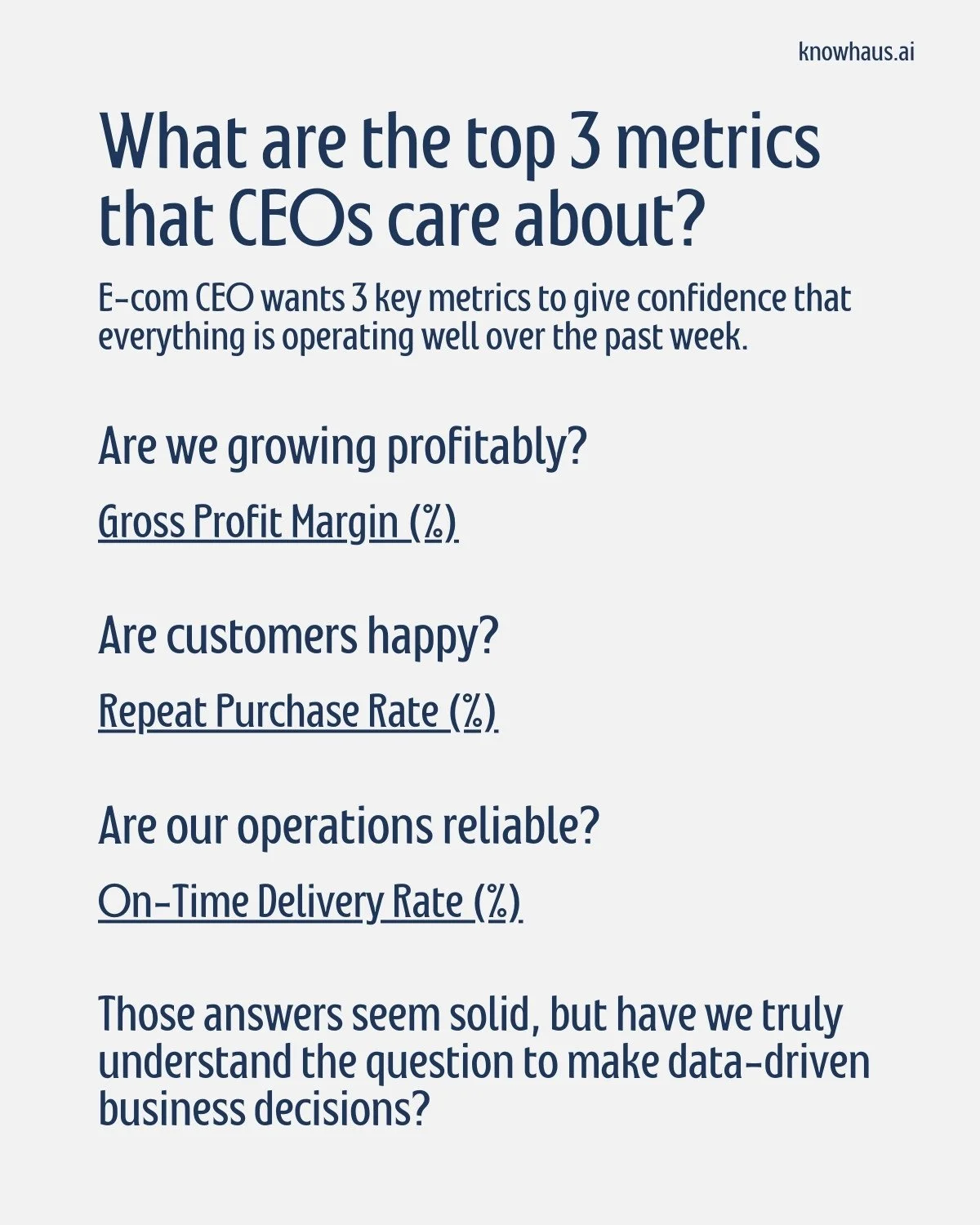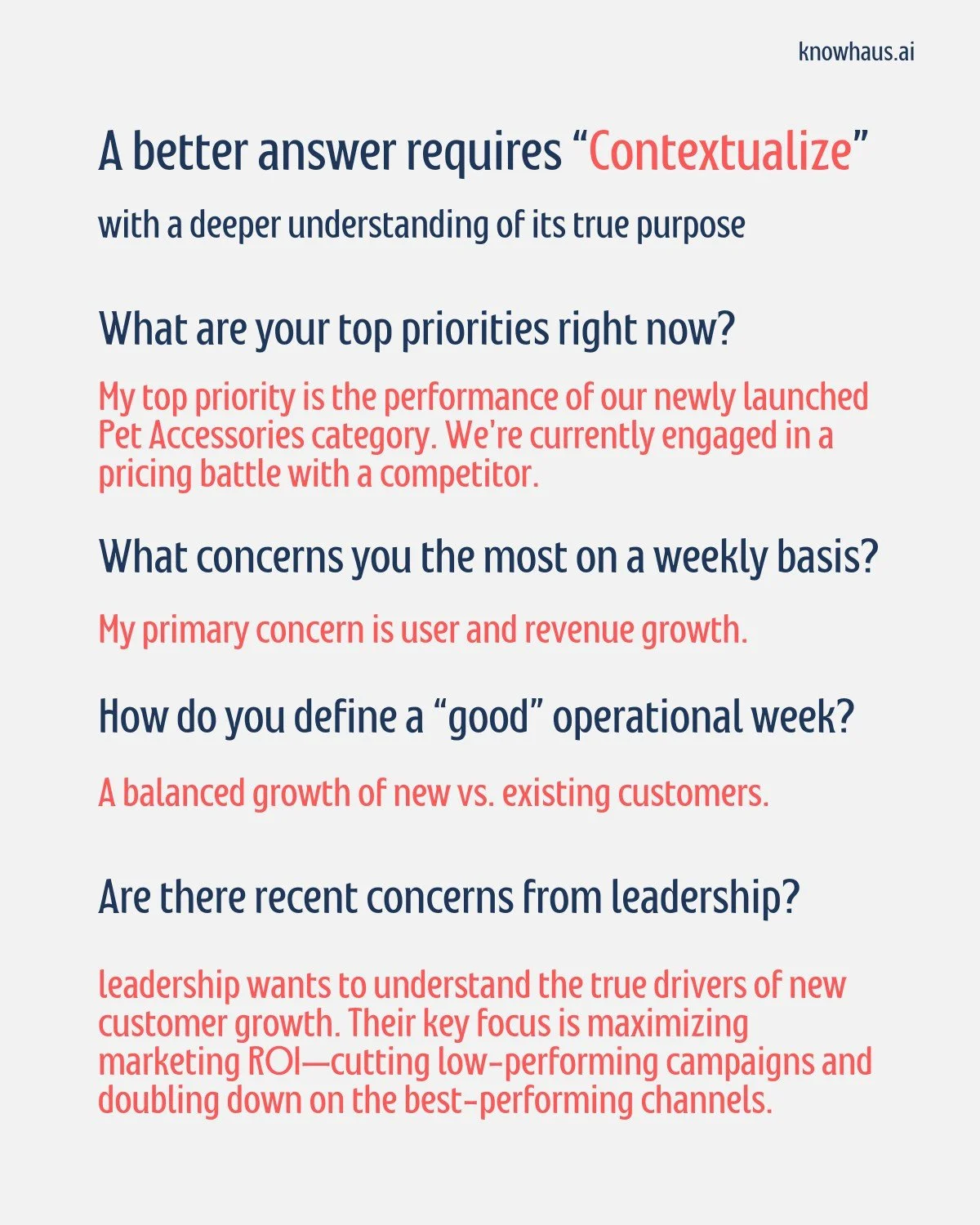How to Contextualize Analytics for Smarter and Faster Business Steering
Introduction
Analytics, in isolation, is just a collection of numbers. But when properly contextualized, it transforms into actionable intelligence, enabling faster and smarter business decisions.
Consider this: A well-known e-commerce platform once posed an intriguing interview question to Data Analyst candidates—"If I were an e-commerce CEO and needed three key metrics to confidently assess business performance over the past week, what would they be?"
Most candidates provided similar responses, listing common KPIs. But the real question is—did they truly understand what was being asked? Context matters, and without it, even the most data-driven answers can miss the mark.
A better answer requires “Contextualize”
In most cases, avoid answering the question outright without first seeking clarification to contextualize the response. Never make assumptions. Instead, ask targeted questions to understand the specific context and priorities before defining the right metrics.
Only after carefully considering the answers to these clarifying questions should you determine which metrics are most relevant.
Here are some example clarifying questions to gain a deeper understanding of what the CEO truly needs:
What are your top priorities right now?
Are you more focused on revenue growth, customer retention, operational efficiency, or something else?
What concerns you the most on a weekly basis?
Are you worried about declining sales, high return rates, customer complaints, inventory issues, etc.?
How do you define a "good" operational week?
Is it hitting a revenue target, maintaining a certain conversion rate, keeping logistics smooth, or something else?
Do you want a high-level view or more granular insights?
For example, would you prefer a single revenue metric or a breakdown of different performance areas (marketing, supply chain, and customer experience)?
Any recent events that could impact last week's performance?
For example, did you launch a new campaign, experience supply chain delays, or run a seasonal promotion?
Once you truly understand the intricacies of what the CEO is looking for, your answers will naturally become more relevant, contextual, insightful, and actionable.
The real value doesn’t just lie in the final answers—it’s in the methodology of how you approach and think through the problem. A well-structured thought process ensures that your insights are not only accurate but also strategically aligned with the business needs.
A framework for contextualization and business steering
We illustrate a structured framework that connects contextualization (understanding what is happening and why) with business steering (predicting what will happen and deciding the best course of action).
1. Contextualization: Understanding the Present & Past
Contextualization in analytics involves making sense of data by answering two fundamental questions:
🔹 What is happening? (Analytics)
This is where descriptive analytics comes in—tracking KPIs, trends, and anomalies in business performance.
Example: A sudden drop in website traffic or sales figures signals a potential issue.
🔹 Why did it happen? (Diagnostic Analytics)
This step goes deeper, investigating root causes behind data patterns.
Example: Did a competitor launch a new campaign? Was there a supply chain disruption? Did a change in UX affect conversions?
By layering diagnostic insights on top of raw analytics, businesses can contextualize their performance and avoid misleading conclusions based purely on numbers.
2. Business Steering: Shaping the Future
Once businesses understand the present and past, the next step is to use these insights to steer decisions effectively. This involves answering:
🔹 What will happen? (Predictive Analytics)
Leveraging AI and machine learning models, businesses can forecast future trends and risks.
Example: Predicting customer churn based on engagement data allows proactive retention strategies.
🔹 What should we do? (Prescriptive Analytics & Action)
Data-driven decision-making must translate into clear, actionable steps.
Example: If predictive analytics suggests declining demand, businesses can adjust pricing, optimize marketing, or enhance customer engagement strategies.
By integrating contextualized insights with predictive foresight, companies can steer with confidence, making proactive rather than reactive decisions.
How to build a system to enable it
To enable fast, contextualized analytics and effective business steering, companies must go beyond traditional data management and build an AI-driven decision intelligence system. This requires integrating data, AI, and automation into a streamlined, decision-ready infrastructure.
Here are the key building blocks needed to power such a system:
✅ Connected Data Sources & a Unified Lakehouse
Establish a single source of truth by consolidating structured and unstructured data from various systems into a Lakehouse architecture.
✅ Fast Data Catalog & LLM-Enabled Integration
Implement an AI-powered data catalog that enables seamless integration and retrieval of both structured and unstructured data—allowing LLMs to surface relevant insights on demand.
✅ Codified Use Case Templates for Business Contextualization
Create a repository of pre-built use case templates that map business questions to relevant data models—accelerating decision-making and eliminating guesswork.
✅ Natural Language to Technical Query Translation
Use AI-powered query translation to allow business users to ask questions in plain language, with the system automatically converting them into technical analytical queries.
✅ Intuitive & Visual Dashboards for Insights Presentation
Present data-driven insights through simple, interactive dashboards that make complex analytics accessible to all stakeholders.
✅ Automated Action Briefings for C-Level Steering
Enhance decision velocity with AI-generated executive summaries that translate analytics into clear, actionable business recommendations aligned with C-level priorities.
Ready to transform your data into actions? Contact us to get started.




